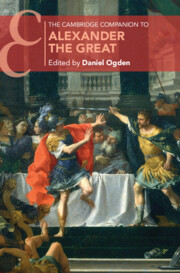112 results
11 - Climb Down from the Tower
-
- Book:
- Be a More Productive Scholar
- Published online:
- 28 March 2024
- Print publication:
- 04 April 2024, pp 226-234
-
- Chapter
- Export citation
6 - Roman Egypt
-
- Book:
- Slavery and Dependence in Ancient Egypt
- Published online:
- 01 March 2024
- Print publication:
- 21 March 2024, pp 274-342
-
- Chapter
- Export citation
Halls of Power: Changing Political and Administrative Culture at the Palace of Westminster in the Sixteenth Century
-
- Journal:
- Journal of British Studies , First View
- Published online by Cambridge University Press:
- 12 March 2024, pp. 1-21
-
- Article
-
- You have access
- Open access
- HTML
- Export citation
11 - Imperial Power, Tribal Settlement and Fiscal Revolts in the Early Islamic Delta (Seventh to Ninth Century CE)
-
-
- Book:
- The Nile Delta
- Published online:
- 15 February 2024
- Print publication:
- 22 February 2024, pp 397-420
-
- Chapter
- Export citation
Five - Standards and the State
- from Part II - Measuring a Kingdom
-
- Book:
- Sicily and the Hellenistic Mediterranean World
- Published online:
- 27 January 2024
- Print publication:
- 22 February 2024, pp 157-200
-
- Chapter
- Export citation
The Construction and Government of Lunatic Asylums and Hospitals for the Insane, by John Conolly
-
- Journal:
- BJPsych Advances , FirstView
- Published online by Cambridge University Press:
- 25 January 2024, pp. 1-5
-
- Article
-
- You have access
- Open access
- HTML
- Export citation
18 - The Administration of Alexander’s Empire
- from Part II - Contexts
-
-
- Book:
- The Cambridge Companion to Alexander the Great
- Published online:
- 04 January 2024
- Print publication:
- 18 January 2024, pp 290-316
-
- Chapter
- Export citation
5 - Alexander and Egypt
- from Part I - Alexander’s Life and Career
-
-
- Book:
- The Cambridge Companion to Alexander the Great
- Published online:
- 04 January 2024
- Print publication:
- 18 January 2024, pp 82-96
-
- Chapter
- Export citation

The Cambridge Companion to Alexander the Great
-
- Published online:
- 04 January 2024
- Print publication:
- 18 January 2024
Chapter 2 - Conciliar Justice at Centre and Periphery
- from Part I - The New Justice System
-
- Book:
- Royal Justice and the Making of the Tudor Commonwealth, 1485–1547
- Published online:
- 02 November 2023
- Print publication:
- 16 November 2023, pp 43-61
-
- Chapter
- Export citation
3 - The Ilkhanate, 1260–1335
- from Volume I Part 1 - Political History
-
-
- Book:
- The Cambridge History of the Mongol Empire
- Published online:
- 01 January 2024
- Print publication:
- 17 August 2023, pp 181-242
-
- Chapter
- Export citation
Runes and Rye: Administration in Denmark and the Emergence of the Younger Futhark, 500–800
-
- Journal:
- Comparative Studies in Society and History / Volume 65 / Issue 4 / October 2023
- Published online by Cambridge University Press:
- 30 June 2023, pp. 828-852
-
- Article
- Export citation
4 - Lawmaking in a Portable Council
-
- Book:
- We, the King
- Published online:
- 02 March 2023
- Print publication:
- 09 March 2023, pp 155-179
-
- Chapter
- Export citation
Chapter 7 - Internal Organisation
- from Part II - Organisation
-
- Book:
- Athletes and Artists in the Roman Empire
- Published online:
- 02 February 2023
- Print publication:
- 09 February 2023, pp 183-248
-
- Chapter
- Export citation
Chapter 4 - All Roads Lead to Rome
- from Part I - History
-
- Book:
- Athletes and Artists in the Roman Empire
- Published online:
- 02 February 2023
- Print publication:
- 09 February 2023, pp 103-116
-
- Chapter
- Export citation
20 - A Materialist Analysis of the Indian Constitution
- from Part III - Analyses
-
-
- Book:
- The Cambridge Handbook on the Material Constitution
- Published online:
- 15 January 2023
- Print publication:
- 05 January 2023, pp 288-300
-
- Chapter
- Export citation
7 - ‘One of Geometry’s Nicest Applications’
-
- Book:
- Underground Mathematics
- Published online:
- 08 December 2022
- Print publication:
- 22 December 2022, pp 213-242
-
- Chapter
- Export citation
5 - ‘So Fair a Subterraneous City’
-
- Book:
- Underground Mathematics
- Published online:
- 08 December 2022
- Print publication:
- 22 December 2022, pp 149-182
-
- Chapter
- Export citation
4 - Politics and the Administrative State
-
-
- Book:
- Robustness and Fragility of Political Orders
- Published online:
- 25 November 2022
- Print publication:
- 24 November 2022, pp 92-114
-
- Chapter
- Export citation
3 - Effective Governance and the Social Dimension of the Rule of Law
- from Part II - What Are Constitutions For?
-
-
- Book:
- Constitutionalism and a Right to Effective Government?
- Published online:
- 20 October 2022
- Print publication:
- 27 October 2022, pp 34-46
-
- Chapter
- Export citation



